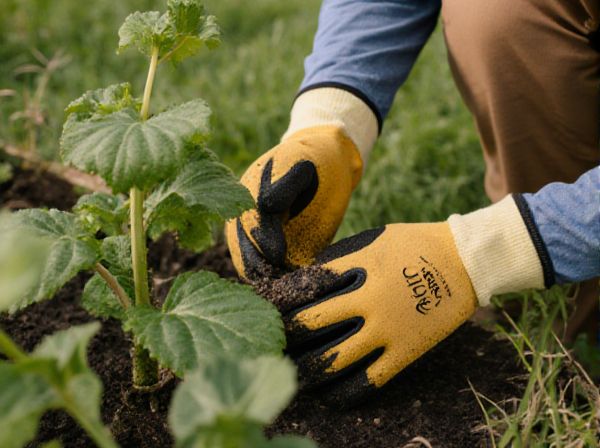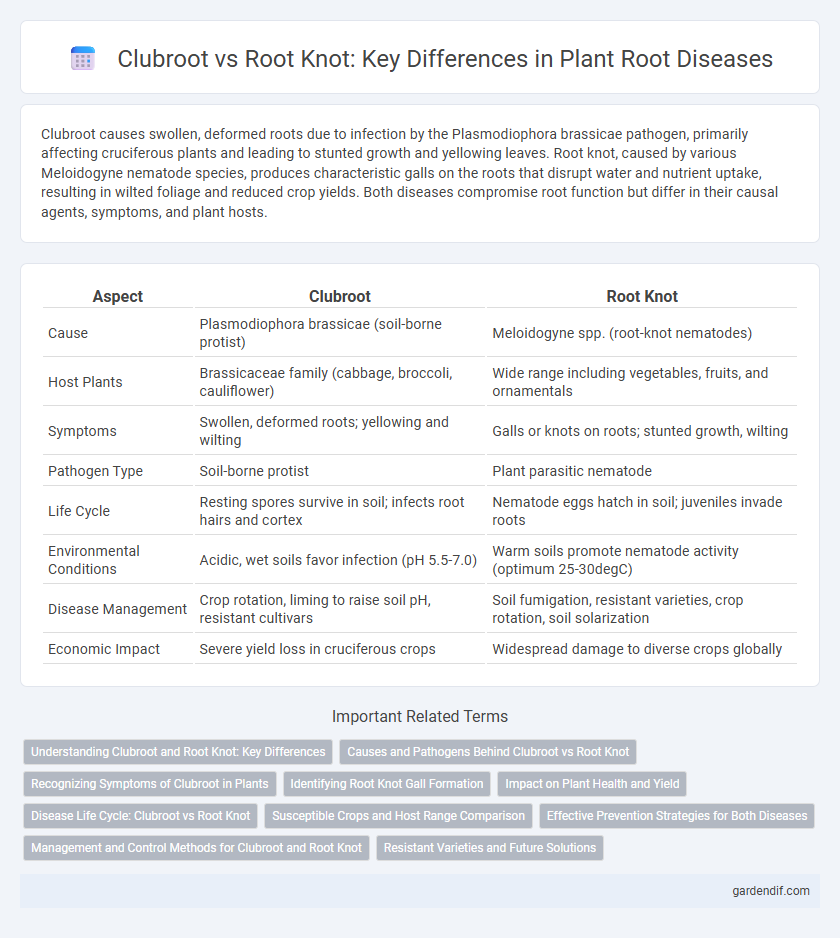
Clubroot vs Root knot Illustration
Clubroot causes swollen, deformed roots due to infection by the Plasmodiophora brassicae pathogen, primarily affecting cruciferous plants and leading to stunted growth and yellowing leaves. Root knot, caused by various Meloidogyne nematode species, produces characteristic galls on the roots that disrupt water and nutrient uptake, resulting in wilted foliage and reduced crop yields. Both diseases compromise root function but differ in their causal agents, symptoms, and plant hosts.
Table of Comparison
| Aspect | Clubroot | Root Knot |
|---|---|---|
| Cause | Plasmodiophora brassicae (soil-borne protist) | Meloidogyne spp. (root-knot nematodes) |
| Host Plants | Brassicaceae family (cabbage, broccoli, cauliflower) | Wide range including vegetables, fruits, and ornamentals |
| Symptoms | Swollen, deformed roots; yellowing and wilting | Galls or knots on roots; stunted growth, wilting |
| Pathogen Type | Soil-borne protist | Plant parasitic nematode |
| Life Cycle | Resting spores survive in soil; infects root hairs and cortex | Nematode eggs hatch in soil; juveniles invade roots |
| Environmental Conditions | Acidic, wet soils favor infection (pH 5.5-7.0) | Warm soils promote nematode activity (optimum 25-30degC) |
| Disease Management | Crop rotation, liming to raise soil pH, resistant cultivars | Soil fumigation, resistant varieties, crop rotation, soil solarization |
| Economic Impact | Severe yield loss in cruciferous crops | Widespread damage to diverse crops globally |
Understanding Clubroot and Root Knot: Key Differences
Clubroot primarily affects cruciferous plants and is caused by the soil-borne pathogen Plasmodiophora brassicae, leading to swollen and deformed roots that hinder nutrient uptake. Root knot nematodes, particularly Meloidogyne spp., infect a wide range of host plants by inducing characteristic galls on roots, disrupting water and nutrient flow. Understanding these pathogens' distinct life cycles and symptoms is crucial for effective disease management and crop protection strategies.
Causes and Pathogens Behind Clubroot vs Root Knot
Clubroot is caused by the soil-borne pathogen Plasmodiophora brassicae, which infects the roots of cruciferous plants, leading to swollen and deformed root galls that disrupt nutrient uptake. Root knot disease is triggered by Meloidogyne species, a genus of plant-parasitic nematodes that invade root systems, inducing characteristic root knots or galls that impair plant water and nutrient absorption. Both diseases significantly impact crop yield but involve different pathogens and modes of infection in the root zone.
Recognizing Symptoms of Clubroot in Plants
Clubroot causes swollen, distorted roots with characteristic galls, leading to stunted growth and wilting in affected plants. In contrast to root knot, which produces multiple small, bead-like knots along the roots, clubroot galls are larger and more irregular. Early recognition of clubroot symptoms, such as yellowing leaves and reduced vigor, is crucial for timely disease management in susceptible crops like cabbage and broccoli.
Identifying Root Knot Gall Formation
Root knot galls caused by Meloidogyne species are irregular, large, and often clustered swellings on the root system, contrasting with Clubroot galls which are typically smooth, spherical, and caused by Plasmodiophora brassicae. Root knot galls disrupt vascular tissue, leading to stunted growth and nutrient uptake issues in affected plants. Proper identification of these galls is critical for implementing targeted nematode management strategies in crop protection.
Impact on Plant Health and Yield
Clubroot causes severe root swelling and distortion leading to nutrient and water uptake disruption, significantly reducing plant vigor and yield, particularly in brassica crops. Root knot nematodes induce gall formation on roots, impairing root function and causing stunted growth, chlorosis, and yield declines in a wide range of crops. Both diseases compromise root systems, but clubroot typically results in more pronounced wilting and overall crop loss due to pathogen persistence in soil.
Disease Life Cycle: Clubroot vs Root Knot
Clubroot is caused by the soil-borne pathogen Plasmodiophora brassicae, which produces resting spores that survive in soil for years and infect root hairs, leading to gall formation during its life cycle. Root knot disease, caused by Meloidogyne spp. nematodes, involves egg hatching in soil, juvenile nematodes penetrating roots, and inducing giant cells and galls that disrupt nutrient uptake. Both diseases rely on soil survival and root infection but differ in pathogen type--protozoan for Clubroot and nematode for Root knot--and mechanisms of root gall induction.
Susceptible Crops and Host Range Comparison
Clubroot primarily affects members of the Brassicaceae family, including cabbage, broccoli, cauliflower, and mustard, with a narrow host range limited to cruciferous crops. Root knot nematodes (Meloidogyne spp.) exhibit a broad host range, attacking over 2,000 plant species across various families such as vegetables, ornamentals, and fruit crops, including tomatoes, carrots, and cucumbers. The susceptibility of crops to clubroot is largely confined to crucifers, while root knot nematodes present a significant threat to a wide variety of agricultural and horticultural plants, complicating management strategies.
Effective Prevention Strategies for Both Diseases
Effective prevention strategies for clubroot involve crop rotation with non-cruciferous plants and maintaining soil pH above 7.2 to limit pathogen survival, while root knot nematode control relies on resistant crop varieties and soil solarization to reduce nematode populations. Implementing proper sanitation, using certified disease-free seeds, and improving soil drainage are critical measures that benefit management of both diseases. Integrated pest management practices combining biological controls, such as nematode-trapping fungi for root knot and biocontrol agents for clubroot, enhance long-term disease suppression.
Management and Control Methods for Clubroot and Root Knot
Effective management of Clubroot (Plasmodiophora brassicae) involves soil pH adjustment through liming to maintain levels above 7.2, crop rotation with non-host plants for 4-7 years, and use of resistant cultivars to reduce pathogen inoculum. Root knot nematode (Meloidogyne spp.) control includes soil solarization, application of nematicides, use of nematode-resistant plant varieties, and incorporation of organic matter to enhance natural antagonists. Both diseases benefit from sanitation measures, such as cleaning equipment to prevent pathogen spread and monitoring soil health to implement timely control strategies.
Resistant Varieties and Future Solutions
Resistant varieties against Clubroot focus on Brassica crops with specific genetic markers that inhibit pathogen entry, while Root knot resistance is often linked to Meloidogyne-specific R genes in crops like tomatoes and cucumbers. Advances in CRISPR gene editing hold promise for enhancing resistance by targeting pathogen susceptibility genes in both diseases. Future solutions involve integrated management strategies combining resistant cultivars, soil health improvements, and biological control agents to reduce pathogen loads sustainably.
Clubroot vs Root knot Infographic

 gardendif.com
gardendif.com